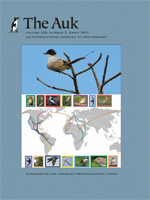The population recovery of Kirtland's Warbler (Setophaga kirtlandii) is one of the most fascinating success stories of an endangered species in the past 60 years. As the author states, the story transcends the bird and its environment. By including the human dimension of recovery efforts, this book keeps the reader involved throughout what ends up being a catalogue of management and research accomplishments. Of particular interest are the personal descriptions of many key individuals that bring the story to life. Without these personal accounts, the book would be easy to put down, but as written, the story that spans several decades is captivating. This well-written book is divided into three parts: the past, the present, and the future.
In the first part, the author successfully uses historical events and people to describe the bird's natural history and the Jack Pine (Pinus banksiana) ecosystem in which it nests. It is in this section that vivid descriptions are given of the species’ discovery, song, and what it takes to find this gray-and-yellow warbler in young, thick stands of Jack Pines in northern Lower Michigan. Key events that defined recovery efforts across decades are described, using historical accounts to provide the point of view of key individuals such as Harold Mayfield and Lawrence Walkinshaw. One chapter is devoted to the problem of nest predation by Brown-headed Cowbirds (Molothrus ater; hereafter “cowbirds”) and how cowbird control contributed to stabilizing the population. This chapter introduces many of the key cowbird trappers and their unique perspective on efforts to save this species. Another significant event that is described well is the devastating Mack Lake Fire that took a life and the property of many residents. The negative attitudes that resulted from the fire helped draw attention to the importance of education and outreach programs in recovery efforts, which at the time had not been used. The people and actions of the outreach program were pivotal in getting the local community involved as part of the recovery effort. This integration resulted in a Kirtland's Warbler Festival to attract tourism into the area and fostered understanding on the importance of early-successional stages of the Jack Pine ecosystem to multiple species, not just Kirtland's Warbler.
In the second part, the focus shifts to describing present-day research. This research is targeting winter habitat in the Bahamas. Research efforts are linking the winter and breeding habitat to better understand the current pressures on the species. The descriptions of challenges that face researchers in a foreign country that has unusual land-ownership laws are particularly interesting, as are the personal stories about finding this bird in remote areas. It is in this section that the annual census is introduced, and personal stories of volunteers who have contributed to this effort for many decades are given. By using the story of a young conservationist from the Bahamas, the author is able to touch on the larger picture of today's conservation efforts between countries and agencies with different agendas, and he shows how one person can make a difference in conservation efforts in the Bahamas. Perhaps most satisfying in this section is the chapter on conflict resolution. Again, the examples presented on key conflicts help make the story even more extraordinary.
The last part, on the future, is the shortest and least developed. The future of Kirtland's Warbler is definitely uncertain, given efforts to delist and the unknowns associated with a changing climate, but the final stages of the story seem incomplete. However, the fairly new idea of establishing trust funds for conservation-reliant species such as Kirtland's Warbler is presented well, and maybe that is the end of the story so far.
By the end of the book, the reader truly begins to understand why so many people come from all over the world to view this warbler. A common thread among individual accounts presented here is the excitement and thrill of finding the elusive Kirtland's Warbler and, once found, the surprise that these birds are quite “friendly.” Although the book is not meant to be a historical documentation of events and individuals, I feel that the failure to mention the contributions of John R. Probst is a major oversight. Dr. Probst, a retired Forest Service researcher, played an integral role on the recovery team for almost 30 years. His many publications on breeding habitat requirements at stand and landscape scales, population limiting factors, and pairing success were important scientific contributions. If the goal was to display the passion that individuals who worked with this bird showed, then Dr. Probst's devotion over decades could have easily been incorporated into the past and present sections of the book.
Though written for the lay person, there are enough historical accounts and information that biologists, ornithologists, and conservationists will find the book useful. This book will make good reading in a graduate seminar on endangered species, policy, and human dimensions. In addition, many readers of this journal and birdwatchers who travel great distances to see this rare bird will find a place on their shelves for this book because the story about the influence of a small bird on communities from two countries and on the careers of many individuals is truly fascinating.





